| Pages:
1
2 |
ScienceHideout
Hazard to Others
  
Posts: 391
Registered: 12-3-2011
Location: In the Source
Member Is Offline
Mood: High Spin
|
|
I can't believe anyone posted- Canadian nickels more than 10 years old are pure nickel!
[Edited on 23-10-2011 by ScienceHideout]
hey, if you are reading this, I can't U2U, but you are always welcome to send me an email!
|
|
|
Intergalactic_Captain
Hazard to Others
  
Posts: 228
Registered: 4-9-2004
Location: somewhere where i don\'t know where i am
Member Is Offline
Mood: frabjous
|
|
Canadian quarters are from 1968-99 are 99.9% nickel as well - A slightly more expensive source, but I find a lot more of them in change than nickel
nickels.
...On a side note, keep your eye out for "war nickels" - one of the strangest American coins I've come across. 1942-45, US nickels were 35% silver,
46% nickel, and 9% manganese - Nickel and copper were so valuable to the war effort that it was literally more economical to make with silver for the
only period in US history...
If you see me running, try to keep up.
|
|
|
Wizzard
Hazard to Others
  
Posts: 337
Registered: 22-3-2010
Member Is Offline
Mood: No Mood
|
|
US 'War nickels' I used to pull of the register on a weekly basis- All silver in circulation has just about dried up completely in the past few years

|
|
|
cyanureeves
National Hazard
   
Posts: 744
Registered: 29-8-2010
Location: Mars
Member Is Offline
Mood: No Mood
|
|
i tried to dissolve one of those war nickels in nitric and had hell doing so. the darn thing kept forming a scab that could be broke off like wet
gypsum but would keep the nickel from further dissolving. it used up more acid than i was willing to spend so i quit when i got it down to a pea size.
i remember this nickel made a thump sound when dropped on concrete.
|
|
|
Intergalactic_Captain
Hazard to Others
  
Posts: 228
Registered: 4-9-2004
Location: somewhere where i don\'t know where i am
Member Is Offline
Mood: frabjous
|
|
Thread successfully hijcacked 
Don't know how I screwed it up, but it's 56% Copper, NOT nickel... And there's still quite a bit in circulation, just nothing compared to what I've
heard before the 80's Hunt bubble, and with the gains in the past 5-6 years what's left has all but disappeared - To put it thiswise, in the past year
working a register I've pulled probably $200 worth of silver at face value in every denomition but halves (still waiting for someone to spend a morgan
dollar). I have a regular that buys hand-rolled halves every time he stops at his bank - Pulled ~60 90% halves and ~100 40% halves in 8 months or so,
not sure how many rolls he's gone through. My explanation is that in these "tough economic times," people are going through their jars of coins and
their inherited collections and spending whatever doesn't "look" valuable enough to keep. Hell, I had a kid come in one night and buy $3 worth of gas
with 12 silver quarters - Should have seen the smile on his face when I offered him $10 for the few left in his pocket. Same thing when I offer $1
for a random dime - Everybody takes the offer, as it's more than they thought they had...
...Back to nickel, I mentioned canadian coins in change for the same reason - You can buy them at face value and they're PURE nickel as opposed to
those in the US. Depending on where you live (I'm 40 miles from the border, dead center between two major tourist cities), you'll find quite a bit of
circulating canadian currency. On a given day at my store, anywhere from .5-2% of the change in any drawer is canadian - Not a bad deal, and with the
exchange rate essentially neutral these days nobody complains - Hell, at least one day a week for the past 2 years the canadian coins were worth more
than their american counterparts...
If you see me running, try to keep up.
|
|
|
ElizabethGreene
Hazard to Others
  
Posts: 141
Registered: 15-10-2012
Member Is Offline
Mood: No Mood
|
|
Resurrecting thread:
I need Nickel Acetate to plate some copper tubes.
This thread and instructable indicated this was possible.
https://www.instructables.com/id/High-Quality-and-safe-Nicke... I attempted and succeeded in making a solution of Nickel Acetate.
Unfortunately I did not achieve the lovely clear blue solution described therein, but I was able to create a dirty brown Nickel Acetate solution that
can plate other metals by electrolysis.
Cell: Plastic, this kit from Amazon: http://amzn.to/2mPYO5G
Electrolyte: Wal-Mart Great Value Distilled White Vinegar
Electrodes: Nickel, rectangular strips approximately 1 inch wide, with 2 inches submerged in the solution. This is the Nickel electrode from the kit
cut in half.
Power Supply: eBay adjustable Lab power supply 0-30v@10 A max.
Observations: Current flow between the electrodes was proportional to the distance between the electrodes. At high current levels (30v @1A electrodes
~ 1/2 inch apart) crystals, assumed to be nickel metal, grew on the negative electrode and the solution became quite warm. The current flow increased
significantly as these crystals grew. Moving the electrodes ~ 3 inches apart and limiting the current to 0.5A (Variable voltage constant current)
reduced this growth significantly. 16 hours of electrolysis at this level resulted in a murky brown solution with some brown precipitate on the
bottom. The positive electrode was dramatically reduced in size and covered in black corrosion. The negative electrode appeared dirty, but
undamaged.
Replacing the negative electrode with a brass tube and running the cell for ~2 minutes at 1.7 volts < 0.1A plated a thin coating of Nickel on the
submerged portion of the tube. The plated brass coating was not easily removed by rubbing or polishing.
My next step is to plate the parts I need plated (the inside of my diffusion pump). Then I'll filter this soup and try to crystallize some clean
Nickel Acetate out of it.
Image 1: Small Crystals visible ~ 10 minutes in:
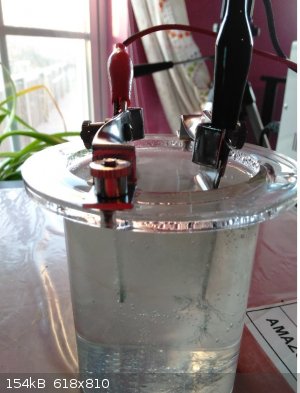
Image 2: Dirty brown soup and plating results:
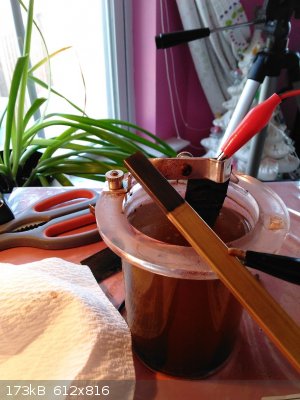
Notes:
I did not add any NaCl to the solution, as conductivity seemed acceptable. It is unknown if this contributed to the unexpected soup result. I will
repeat the experiment to test this variable.
A previous attempt with nickel and carbon electrodes was a failure, as I had the polarities reversed (a carbon rod as positive and the nickle
electrode negative). This resulted in a significant amount of pitting on the carbon electrode, no significant effect on the nickel electrode, and a
brown solution that smelled strongly of vinegar with a black precipitate at the bottom of the cell. The Black precipitate was assumed to be carbon
from the rod, and this suspicion was confirmed by heating the precipitate to red heat for several minutes in an open ceramic crucible. The material
disappeared with no obvious visible ash presumably oxidizing into CO and CO2. This solution would not plate any material onto a test solution. After
filtering I boiled the solution to dryness with a brown flaky (burnt) precipitate. A propane torch flame test of the small amount of residue
remaining did not indicate nickel present, and was discarded as household waste.
I will also repeat the experiment to test how well a carbon rod holds up as the negative electrode.
Given the significant dissolution of the Electrode, I'll likely be looking for another electrode source soon too.
|
|
|
S.C. Wack
bibliomaster
    
Posts: 2419
Registered: 7-5-2004
Location: Cornworld, Central USA
Member Is Offline
Mood: Enhanced
|
|
If this works sort of like the writer claims but one is not going to experiment using those exact directions, substitution of the vinegar with acetic
acid is an attractive choice.
|
|
|
ElizabethGreene
Hazard to Others
  
Posts: 141
Registered: 15-10-2012
Member Is Offline
Mood: No Mood
|
|
Quote: Originally posted by S.C. Wack  | | If this works sort of like the writer claims but one is not going to experiment using those exact directions, substitution of the vinegar with acetic
acid is an attractive choice. |
Agreed, I suspect I would have had far better results with glacial acetic acid.
|
|
|
RebekAbrin
Harmless

Posts: 3
Registered: 11-3-2017
Member Is Offline
|
|
You can use nickle carbonate to react with vinegar or glacial acetic acid.
|
|
|
BILLBUILDS
Hazard to Self
 
Posts: 82
Registered: 19-3-2016
Member Is Offline
Mood: No Mood
|
|
you can buy 50-100g of powdered copper on ebay for about 10-20 bucks. sorry if someone already mentioned it but it would be alot easier powdered
|
|
|
ElizabethGreene
Hazard to Others
  
Posts: 141
Registered: 15-10-2012
Member Is Offline
Mood: No Mood
|
|
I cleaned up this morning and couldn't escape the nagging suspicion that my brown muck was iron oxide. This could happen if my "nickel electrode"
happened to be plated. I'm repeating the attempt now using US Nickels (75% copper, 25% Nickel)
I 3d printed some shorter electrode holders too.
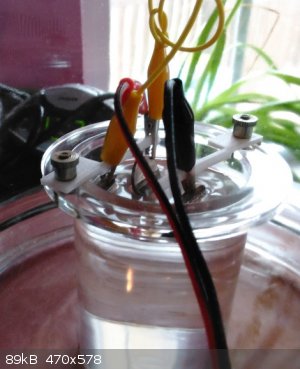
~30 minutes in at 30v < 0.1 and my solution now has the expected light blue tint to it and no observable brown muck. A significant number of
expletives were noted, and a review/note to the seller of the "nickel" electrode will be posted shortly. This returns me to a problem mentioned
earlier in the thread, separation of Nickel and copper acetate. I intend to try plating out one of the metals as mentioned by an earlier poster.
Other posters had questioned the legality of destroying these coins. I've reviewed the law https://www.usmint.gov/downloads/consumer/FederalRegisterNot... and believe this practice to be legal as I will not be passing the treated coins
off fraudulently and will not profit from the destruction of these coins for the metals therein.
The law says:
§ 82.1 Prohibitions.
Except as specifically authorized by the Secretary of the Treasury (or designee) or as otherwise provided in this part, no person shall export, melt,
or treat: (a) Any 5-cent coin of the United States; or (b) Any one-cent coin of the United States
§ 82.2.2.b
The prohibition contained in § 82.1 against the treatment of 5-cent coins and one-cent coins shall not apply to the treatment of these coins for
educational, amusement, novelty, jewelry, and similar purposes as long as the volumes treated and the nature of the treatment makes it clear that such
treatment is not intended as a means by which to profit solely from the value of the metal content of the coins.
|
|
|
DraconicAcid
International Hazard
    
Posts: 4334
Registered: 1-2-2013
Location: The tiniest college campus ever....
Member Is Offline
Mood: Semi-victorious.
|
|
Iron is easy to separate from nickel with ammonia- nickel forms a soluble complex ion, and the iron precipitates out as the hydroxide. Evaporation of
the solution followed by gentle heating should get rid of the ammonia ligands.
Please remember: "Filtrate" is not a verb.
Write up your lab reports the way your instructor wants them, not the way your ex-instructor wants them.
|
|
|
ElizabethGreene
Hazard to Others
  
Posts: 141
Registered: 15-10-2012
Member Is Offline
Mood: No Mood
|
|
Thank you very much Draconic. I'll use that to clean up my jars of soup. What happens to the acetate ions in that reaction?
|
|
|
DraconicAcid
International Hazard
    
Posts: 4334
Registered: 1-2-2013
Location: The tiniest college campus ever....
Member Is Offline
Mood: Semi-victorious.
|
|
They stick around to be counterions to the nickel complex ion. Some of them will probably form ammonium acetate, though.
Please remember: "Filtrate" is not a verb.
Write up your lab reports the way your instructor wants them, not the way your ex-instructor wants them.
|
|
|
OldNubbins
Hazard to Others
  
Posts: 136
Registered: 2-2-2017
Location: CA
Member Is Offline
Mood: Comfortably Numb
|
|
Been lurking for a while but thought I would chime in since I have done this before. I used regular distilled white vinegar (5%) and Nickel 99 welding
rods. The rods are 99% nickel and a little pricey around $30/lb. You can find them at welding supply shops or online. To generate the nickel acetate I
ran the initial electrolysis in a mason jar with a welding rod at both the cathode and anode and would reverse polarity occasionally to keep anode
erosion even between the two. The trick is to NOT stir the solution when the green acetate begins to form. It will sink to the bottom and keep the
solution on top relatively free of ions. I also kept the cathode higher up in solution to minimize plating and keep as many ions in solution as
possible. It took about 3 days and I would occasionally crank up the amps until the solution got hot to speed up the process. The solution was a nice
clear green. Plating was pretty fast and the shiny new penny I used as a test came out much shinier than I expected. If you plate something with a
rough finish, the nickel will be dull and grey but can be polished up with some elbow grease.
|
|
|
ElizabethGreene
Hazard to Others
  
Posts: 141
Registered: 15-10-2012
Member Is Offline
Mood: No Mood
|
|
As of this morning the electrolysis is still going. I have a clear blue-green solution with two precipitates. A dark green "beard" is growing on the
negative coin (right), with some accumulated below the coin. The positive coin has a small amount of a gold colored precipitate on the back and below
it (left). I removed the both coins from the bath to adjust the electrical connection and discovered the negative covered with a dark brown coating
that wiped away easily with a paper towel. The positive coin has significant pitting and wear.
Attempt 3, Day 2
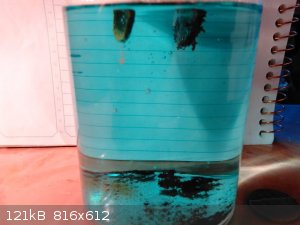
|
|
|
tsathoggua1
Hazard to Others
  
Posts: 335
Registered: 8-1-2017
Location: Beyond the pale
Member Is Offline
Mood: Phosphorescent
|
|
Would it not be better to use NiCl2 for plating? that way you'd at least be dealing with easygoing inorganic species, more predictable than having the
organic acetate floating about. Organic electrolysis reductions can be finicky at best.
Those nickel crystals, were they dendritic in form? looks that way? how stable are they? I.e can they support their own weight outside of the
electrolyte? what sort of dimensions do they have?
[Edit-meant to add-guitar fret wire contains nickel, not sure how much but they are AFAIK nickel based] Worth checking how much there is in the wire
though. I often use pieces for electrodes.
If I may add a question, does molten caustic alkali (group I, Na, K) attack nickel, or can it be used as a plating to protect carbon crucibles from
attack during electrolysis? (the idea behind the carbon crucibles is to try for electrolysis and preparation of metallic Na using an induction heater)
[Edited on 14-3-2017 by tsathoggua1]
|
|
|
ElizabethGreene
Hazard to Others
  
Posts: 141
Registered: 15-10-2012
Member Is Offline
Mood: No Mood
|
|
Quote: Originally posted by tsathoggua1  | Would it not be better to use NiCl2 for plating? that way you'd at least be dealing with easygoing inorganic species, more predictable than having the
organic acetate floating about. Organic electrolysis reductions can be finicky at best.
|
I have no data on this. I'm reproducing the procedure from YouTube videos with my unique contribution being an attempt to suss out how to extract
nickel from Nickels.
| Quote: |
Those nickel crystals, were they dendritic in form? looks that way? how stable are they? |
The nickel crystals in the nickel-steel electrolysis were tree-like, but very fragile. Banging the desk caused them to fall right off.
Re guitar strings, you're right. There are some specialty strings with solid nickel cores.
| Quote: | If I may add a question, does molten caustic alkali (group I, Na, K) attack nickel, or can it be used as a plating to protect carbon crucibles from
attack during electrolysis? (the idea behind the carbon crucibles is to try for electrolysis and preparation of metallic Na using an induction heater)
|
Nickel is used as an electrode in the https://en.wikipedia.org/wiki/Castner_process, so it has to withstand NaOH and molten Na. My very limited understanding is that there is a narrow
band of temperatures where the salt is molten and the Nickel doesn't dissolve in the melt.
|
|
|
ElizabethGreene
Hazard to Others
  
Posts: 141
Registered: 15-10-2012
Member Is Offline
Mood: No Mood
|
|
Attempt 3, day 3
Ran electrolysis overnight. This morning there was zero current flow and the solution level had dropped noticeably.
Half of the positive coin has been digested. The Negative coin is covered with a flaky brown deposit believed to be copper.
I'm now attempting to "plate out" the copper from the solution.
I exchanged a brass test electrode for the negative coin and replaced the positive half-coin with another Nickel. In this configuration I was able to
plate what looked like copper onto the negative brass test electrode.
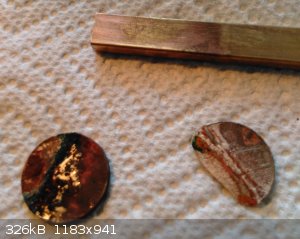
At 20v, the positive coin was producing copious amounts of gas, leading me to believe that it was dissolving additional Nickel and Copper into the
solution. I reduced the voltage by halves until no gas production was visible on close examination, between 1500 and 700 mV. These figures do not
compensate for voltage drop in the wiring or clamps.
The solution is currently quite blue which I believe indicates a significant amount of copper. I'll continue running this low voltage and slow
electrolysis through the night and report results tomorrow. I feel like I should remove the accumulated stuff, believed to be a copper compound, off
of the bottom but have not done so yet.
|
|
|
ElizabethGreene
Hazard to Others
  
Posts: 141
Registered: 15-10-2012
Member Is Offline
Mood: No Mood
|
|
Attempt 3, day 4
The submerged portion of the brass negative electrode has a well-adhered copper-colored coating. The formerly clear solution has is now slightly
cloudy, with a clear separation between the clear and cloudy layers ~ 1 inch from the bottom of the cell. The color of the solution has not changed
noticeably.
Increased voltage to 1000mV. Measured current was < 1mA, cleaning alligator clips raised current to 3mA.
|
|
|
ElizabethGreene
Hazard to Others
  
Posts: 141
Registered: 15-10-2012
Member Is Offline
Mood: No Mood
|
|
Attempt 3, day 5
I made a foolish choice in using a brass test electrode. It has a strongly adhered copper coating, yes, but I've realized that coating isn't from
electrolysis at my tiny current levels. I think it's exchanging zinc ions for copper, and the zinc is the source of my solution's cloudiness. I'll
be playing with it more later today.
|
|
|
tsathoggua1
Hazard to Others
  
Posts: 335
Registered: 8-1-2017
Location: Beyond the pale
Member Is Offline
Mood: Phosphorescent
|
|
Didn't mean guitar strings. Fret wire. The metal wire with a trigonal structure that is set in the fingerboards to produce the frets. Old man was a
guitar maker, and there are buckets and buckets of short lengths of scrap fret wire a few inches long that have been serving as a ready source of
nickel/plated electrodes for NaOH electrolysis. Effective enough to say the least, given the power supply being used (30-35A/5-10V) had to dive for
cover after that one. Working on better shielding design for an electrolytic cell, but it does make good electrodes for Na production.
Didn't get much metal from the first test runs however, since most of took no notice of the argon flow even when directed as a jet from mm away and
the result was a sodium rain and a chemist thankful for a face-covering blast shield
Looking into constant-current power sources though for better regulation and autocorrecting for changes in melt chemistry when using eutectics, as
well as less fuss about electrode spacing.
Has anyone a suggestion on best setup to plate out Ni from the acetate
|
|
|
ElizabethGreene
Hazard to Others
  
Posts: 141
Registered: 15-10-2012
Member Is Offline
Mood: No Mood
|
|
I attempted to plate the copper out of my solution and have met with some success. I exchanged the Nickel coin positive electrode for a carbon rod,
and retained the brass strip as the negative electrode. Overnight electrolysis at 5v and ~100mA caused a significant accumulation of brown powdery
material on and below the negative electrode. I scraped off and dried a sample of the powder and it appears visually to be copper powder. The
solution is much lighter in color and less blue now too.
I think I can report some preliminary findings based on results to date.
Confirmed:
1. If you want nickel acetate, you can make it by electrolysis with a positive nickel electrode and a carbon or nickel negative electrode in
Great-Value distilled vinegar.
2. If you want to plate nickel, you can do this using a positive nickel electrode, vinegar and/or nickel acetate solution electrolyte, and the item to
be plated as the negative electrode.
3. Many eBay and amazon sellers offer "Nickel" electrodes that are actually plated. Attempting to plate with these or make Nickel Acetate with them
is initially promising, but when the plating erodes and exposes the base metal things go awry.
4. For electrolysis, cover your alligator clips and screw threads with petroleum jelly to dramatically reduce corrosion. Steel screws, nuts, and
alligator clips will rapidly corrode to uselessness when exposed to vinegar fumes and condensation.
5. The carbon rods extracted from a lantern battery work well as electrodes, but should be scrubbed thoroughly beforehand. Mine still had adhered
black battery goo after more than a year in storage, and I remember washing them before I stored them.
Preliminary:
6. It is possible to dissolve US 5 cent coins to extract their metal content via electrolysis in vinegar. A 5 gram coin contains 1.25 grams of nickel
and 3.75 grams of copper. The coin(s) should be the positive electrode(s). High voltage (25v) can be used to rapidly dissolve the coins, but care
should be taken to keep the solution at a reasonable temperature. A brass or copper negative electrode is acceptable. A brown powder will form on
the negative electrode. This is copper. The majority of the nickel should remain in solution until the copper is removed. When a sufficient
quantity of Nickel is in the solution, remove the coin positive electrode and replace it with a carbon rod. Filter the solution to remove any copper
precipitate, wipe off the negative electrode, and perform low voltage (5v) electrolysis. Occasionally remove and clean the negative electrode.
Theoretical:
6 cont: When it stops forming a brown coating and starts forming a gray coating, stop electrolysis as the majority of the copper has been removed. At
this point filter the solution, boil it down, and crystallize the Nickel Acetate. A flame test of the brown powder should be green for copper, but a
flame test of the Nickel acetate should be mostly clear.
7. The iron in the steel-nickel soup from using plated electrode can be precipitated using ammonia. After filtering, the Nickel in the solution can
be recovered by gentle heating. Given the small amount of nickel present in the solution it may make more sense to evaporate the solution to dryness,
then heat the waste product to convert it to metal oxides. In small quantity these should be safe for disposal as household waste.
Room for improvement:
I need to find a way to dissolve multiple coins simultaneously. I could melt them together in my Arc furnace, but that's not exactly amSci friendly.
A basket-like arrangement might be better.
I need a test to tell if there is between nickel in my copper powder to help nail down the acceptable parameters for plating out.
Follow-up:
I'm going to mix the copper powder with some borax and torch it to see if I can get it into a tiny ingot.
|
|
|
| Pages:
1
2 |